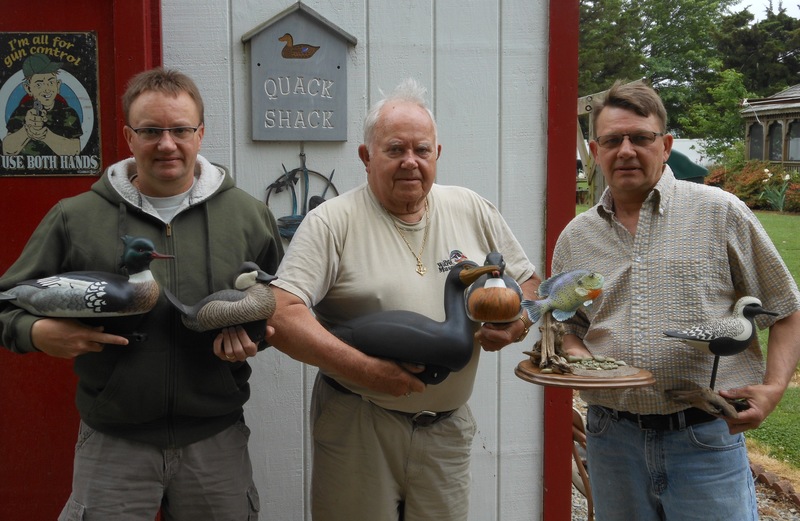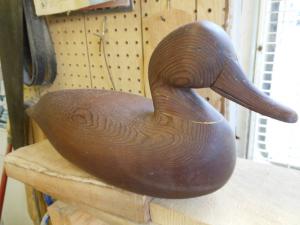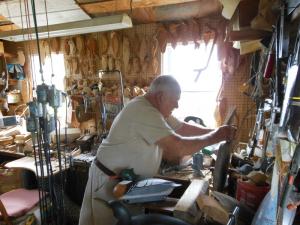Belote boys love their decoys

Richard Belote grew up in a small town on the Eastern Shore of Virginia called Painter. He spent his days hunting on the oceanside of the peninsula, in the numerous bays protected by barrier islands.
Richard learned to hunt watching his dad, who was a market hunter before it became illegal. His dad's spot of choice was Hog Island Bay. He would kill three to four barrels of ducks a week, said Richard, and they would be shipped to Philadelphia and New York.
Now 81, Richard has been carving duck decoys since 1951, when he was a teenager.
“I wanted to go hunting and didn't have any decoys,” he said from his living room in Lewes. “We didn't have the money to go and buy decoys, so we tried to make something that looked like a duck.”
It's a skill that he has honed over time. Year after year, the men of the Belote family are recognized at the Ward Museum of Wildfowl Art's annual carving competition.
This year was no different. Richard and his sons, Ames and Scott Belote together won 10 awards at the museum's 44th annual World Championship Wildfowl Carving Competition in Ocean City – with four recognized as the best in its category or division.
While the men are proud of their awards, they all say it's a love of the birds and the time spent creating their likenesses that motivates them to spend hours alone in a shop at all times of the day.
“I don't really think I'm that good," said Richard. "I can make a decent looking duck, but Scott can make a duck that puts mine to shame.”
Ames, 56, didn't start carving until 1998, and he started with fish. His passion for the craft came later in life, but with a father and brother with nearly 100 years of experience between them, it was a skill that came naturally.
Ames said there aren't too many fish carvers on the East Coast of the United States, and his favorite fish to carve include trout, sunfish, stripers and stingrays. He's modest about his skills, but proud also.
“I can carve a fish that's more realistic than a fiberglass mount,” he said.
Scott, 50, began carving before he was 10 years old. He has a quality-over-quantity approach to his carvings.
“I'm not in it for the money. I'd be a poor man if I was,” he said.
Scott has taught classes on carving and painting carvings at the museum. Scott, himself, has never taken any lessons, but he understands that in today's society if the art is going to be passed along, providing classes that promote carving is a good way to do it.
“It's a dying art, and I'm just trying to get kids interested,” he said. “It's a heritage thing. The kids don't care about the way of life that we had. It's the original folk art of the United States. ”
Scott said he will put hundreds of hours into a single decoy, but he rarely does one at a time.
“I tend to jump around. I'll end up with 20 pieces that I need to finish,” he said laughing.
All three men gathered at Richard's house in Lewes, whose living room is wall-to-wall decoys, waterfowl art and birding books.
The sons smile and nod their heads yes when asked if their houses are similarly decorated.
“I've got too many,” said Scott. “I've got my own best collection and at least 60 study mounts.”
All three said they use power tools sparingly because using their hands and hand tools allows them to feel the areas that need work and it produces a better product.
“For my fish, I only use a knife and burning tool,” said Ames. “There's a better feel when you use your hands. I can close my eyes, rub my hands over my carving and see it in my mind.”
Scott said the feel of the carving in the hand is just as important as seeing it.
“You can feel things that you wouldn't see with your eyes,” he said.
The sons say its years of hunting and fishing with their father that taught them the shapes of animals they carve.
“It's a sense that comes from experience. It allows for a much better feel,” said Ames. “When you catch a fish and rub it between your hands, you can feel the curves in its body and its thickness.”
“If it wasn't for our dad, neither one of us would have gotten into this,” said Scott.
Richard said some people who want to get into carving have no real concept of what the bird looks like, and sitting there and staring at a painting or another carving for two weeks isn't going to work.
“You can try to make it as real as possible, but you can't match the good lord,” he said.
Scott said the challenge is capturing the specific characteristics of each bird species.
“There are no ugly birds or animals. They're all beautiful and unique,” he said.
Chris Flood has been working for the Cape Gazette since early 2014. He currently covers Rehoboth Beach and Henlopen Acres, but has also covered Dewey Beach and the state government. He covers environmental stories, business stories and random stories on subjects he finds interesting, and he also writes a column called Choppin’ Wood that runs every other week. He’s a graduate of the University of Maine and the Landing School of Boat Building & Design.

























































